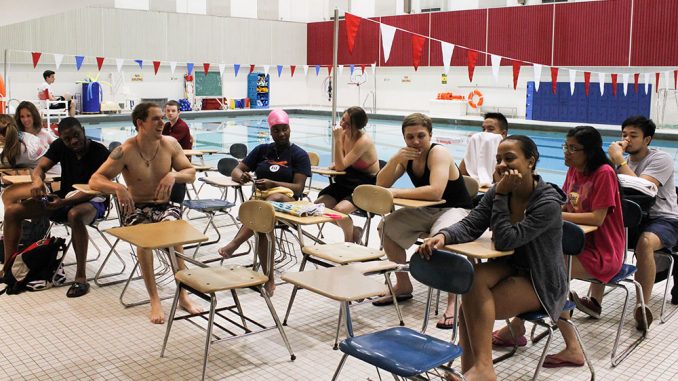
Brandon Yarde plants his feet on the wall of the swimming pool and pushes backward. He glides through the water with ease. As his momentum slows, he floats on his back and gazes upward, relaxed. Just last semester, the senior kinesiology major had no idea how to swim.
Now, Yarde joins 25 other students in a pool in Pearson and McGonigle halls twice a week for Swimming for the Non-Swimmer, a two-credit kinesiology course. The class is encouraged for students with minimal swim experience.
Louis Schoener, the course instructor, said roughly 40 percent of students who take the course each semester never learned how to swim.
“There are about eight or nine [students for whom] just getting their feet off the bottom [of the swimming pool] was a major accomplishment in the first week and a half to two weeks,” Schoener said.
Among them is Yarde, who grew up in Brooklyn, N.Y.
“I lived in the city,” Yarde said. “There aren’t really a lot of pools. I know a lot of people that know how to swim have had pools in their backyards or something like that, but not me.”
Swimming for the Non-Swimmer fulfills the aquatic requirement for kinesiology majors. For this reason, Schoener said many students are inclined to participate, regardless of their skill level.
Ian Mee, a junior kinesiology major, works as a lifeguard for the class throughout the semester.
“I would say over 60 percent of the class knows how to swim,” Mee said. “They’re just taking the class because they have to take it. So [Schoener] really just focuses on the kids that don’t know how to swim, and lets the kids that know how to swim just go through the class.”
Mee said he’s only had to get in the water once, when a student had a cramp in his leg. Schoener said Mee is helpful and frequently stays after the scheduled class time while Schoener works individually with students who need extra help learning how to swim.
“A lot of times it’s more like psychotherapy,” Schoener said. “Basically for those people for whom the class is intended, what you’re trying to do is get them to acknowledge that this environment is not something that’s controlling them – it’s the other way around.”
Senior kinesiology major Vincent Omekam said Schoener frequently dedicates time outside of class to help students.
“One girl in the class, she wouldn’t get in the water,” Omekam said. “I don’t know what happened to her, or if she was afraid or what. And then like four days in, she finally gets in, and Schoener spends a lot of time with her. And now look how she’s swimming.”
Omekam said the class has helped him personally as well.
“[Swimming for the Non-Swimmer] fulfilled an aquatics requirement, and it was an opportunity for me to develop a very basic yet essential life skill that everybody should have,” Omekam said. “It’s fun at the same time. It’s different from my other classes. It gives me a break from the tough stuff – senior capstones and figuring out what I’m doing with my life.”
Omekam said he initially struggled with relaxing in the water, but with Schoener’s help, he’s been able to establish his confidence as a swimmer.
“Just putting [students] in a situation where you know they can do it, and they might not believe you, but you know they can do something,” Schoener said. “And once they do it, then you’ve gone one step further than you were before. Then suddenly they get that sense of confidence in the water and they’re able to do things.”
Yarde, one of the few students who had no previous swim experience, said the class isn’t what he expected.
“It’s been kind of challenging because I didn’t know how to swim at all, but since it’s not boring, the challenging part of it isn’t that bad,” Yarde said. “I didn’t want to take this class at all. That’s why I’m taking it my last semester senior year. But now that I’m here, I know it’s not bad.”
Another kinesiology course, titled Swimming, is targeted toward students who feel more comfortable in the water. Schoener said Swimming for the Non-Swimmer covers just the basics of learning how to swim.
Campus Recreation also offers swimming courses that are open at no charge to Temple students, staff, administration and their children. These instructive sessions are part of the Learn to Swim program, divided into three levels: Water Exploration, Primary Skills and Stroke Preparation.
Omekam said regardless of how a person gets there, it’s important for many students to overcome the fear of swimming.
“It’s been a great experience so far, to say the least,” Omekam said. “Just try. Just get in the water.”
Claire Sasko can be reached at claire.sasko@temple.edu.



Be the first to comment